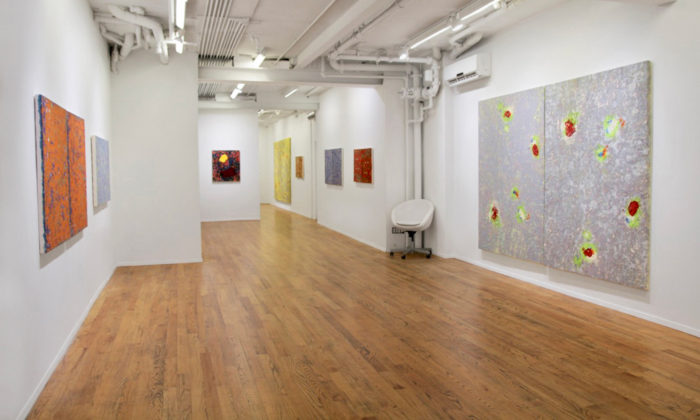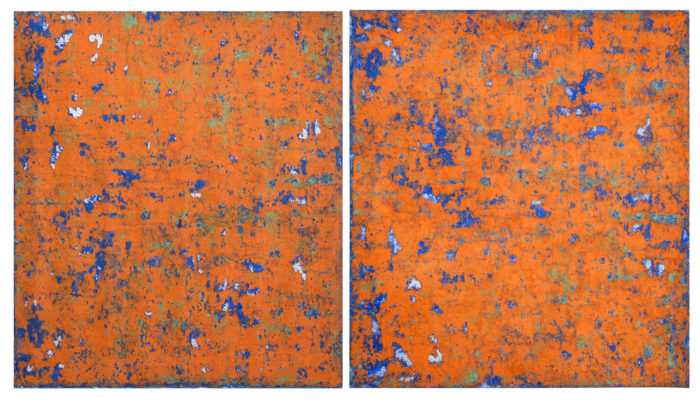
Rainer Gross is a seventy years old German painter, who is originally from Cologne but spends most of his time in New York. His show, entitled “Contact Paintings,” consists of work originated by his placing together, overnight, two canvases of the same size, each of them covered by six or seven layers of paint, neither in patterned nor in a monochromatic fashion. Removing the two canvases that had been in contact the next day, Gross turns the results upside down and shows them as closely related but not exactly mirroring images of each other. Indeed, part of the experience of the composition has to do with his audience linking parts of the two more or fewer twin compositions in their gaze. As examples, both of the works that are closely related and also independent of each other, having been deliberately made by the artist and also by chance. Thus, the paintings operate along a spectrum of esthetic choices, not necessarily easily seen. I mean by this that they occupy places that are deliberately ambiguous, on both a materials and thematic level. Thus, the supposed twin paintings are, and are not, the same. Gross is not the first artist to leave work to chance; more than a few contemporary painters have left their work outdoors in order for the compositions to pick up the influences and changes created by the climate and weather. Interestingly, though, in Gross’s case, the art turns out to be remarkably expressive, to the point of highly attractive feeling, despite the restraint and impartiality of its facture.

Impression and Line (2013-16) is an excellent painting made up of a thin, curving line that overlaps twice, once tightly and one more openly, occupying most of the space of the work, whose background is a light gray. The thin stripe is made up of variegated colors, many of them blue. One has a difficult time figuring out how the line was made by an impression, but it is a beautiful image, haunted by ghost stripes curving underneath it as part of the gray background. In this painting, as in most of Gross’s work, we don’t ask what it means so much as we simply admire it. Abstraction is only very rarely associated with social outwardness–the best examples come from the Russians practicing Constructivism and Suprematism, although it is very little or no overt political assertion I can think of in that work (the politics were generated by association rather than artistic example). In a formal sense, nor do Gross’s non-objective paintings openly evidence the intricacies, active and passive, of their making. Instead, we confront a beautiful non-naturalistic image, sufficient and moving in its own right. Halston Twins (2018) consists, beautifully, of a pair of two reddish, wine-colored abstract paintings, embellished regularly and often, by white patches, themselves seemingly attached to the edges of slate-blue lines, really skeins, of paint. It’s been known a long time that abstract art is a style beautiful in its own right, without the formalist demands of representation. But it is also true that the practice of non-objective art, now longer than a century, is easily diminished by a sense of repetition and familiarity.


How does Gross avoid this problem? By generating the image partially through means independent of his own efforts, he abstracts its manufacturing process, as well as its appearance. This is a decidedly contemporary move. Even if we cannot actively tell the means by which he made the painting, we can experience the closeness of the imagery between the side-by-side compositions as a bit of industrialized creativity, although its means are only slightly mechanical. The early painting (1992) titled the Lindner Twins looks like a near relative of work done by the American-born, French-based artist Joan Mitchell, whose messy, impastoed paintings are echoed in this effort by Gross. Composed of masses of orange strokes on top of equally disheveled groups of dark blue ones, with a white ground rising up, in small ways, through the two layers of paint, the Lindner Twins keep alive a painting tradition originating in New York but practiced more widely than imagined. Abstraction travels particularly well via books and magazines and, now especially, the Internet, so it makes sense that painters all over the world would embrace a style that is so emotionally vibrant and free (and so they do). Gross, living in New York and in eastern Long Island, has managed to internalize this way of working, even if he isn’t fully responsible for its appearance, which connects with a history not nationally close to him. As a result, we see nonobjective painting kept alive in ways we did not think were so easily available, especially from someone geographically distant from the New York School. In fact, the results have turned out to be inspired.
Rainer Gross at Galerie Richard
September 4 – October 26, 2019
121 Orchard St, New York, NY 10002
T: 212-510-8181

Thanks ? for the review!
Nice to hear ? that my work resonates!
~Rainer
Congrats on the show!